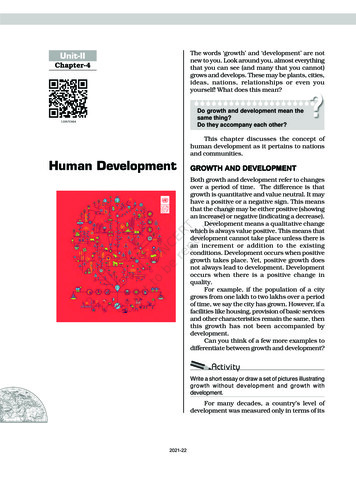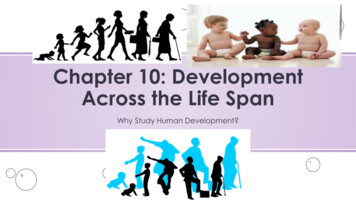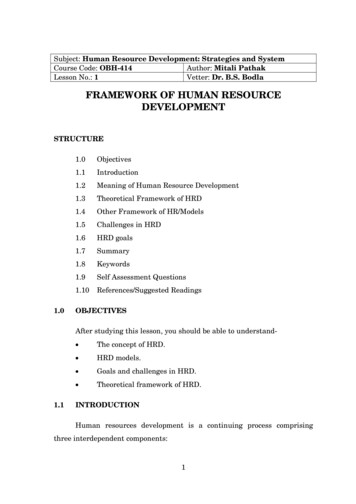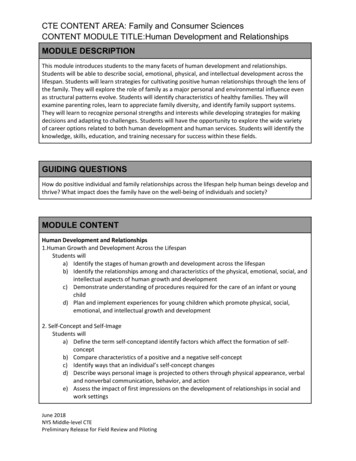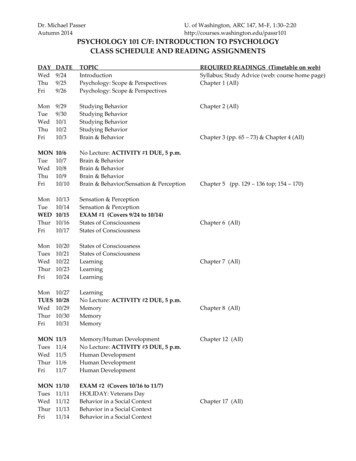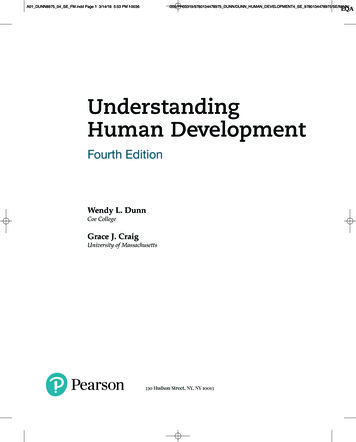
Transcription
A01 DUNN8975 04 SE FM.indd Page 1 3/14/18 5:53 PM f-0036/205/PH03319/9780134478975 DUNN/DUNN HUMAN DEVELOPMENT4 SE 9780134478975/SE/MAIN/ .UnderstandingHuman DevelopmentFourth EditionWendy L. DunnCoe CollegeGrace J. CraigUniversity of Massachusetts330 Hudson Street, NY, NY 10013
A01 DUNN8975 04 SE FM.indd Page 2 3/14/18 5:53 PM f-0036/205/PH03319/9780134478975 DUNN/DUNN HUMAN DEVELOPMENT4 SE 9780134478975/SE/MAIN/ .Portfolio Manager: Tamimaa MehraPortfolio Manager Assistant: Anna AustinProduct Marketer: Jessica QuazzaContent Developer: Robyn AlvarezContent Development Manager: Gabrielle WhiteArt/Designer: iEnergizer/Aptara , Ltd.Digital Studio Course Producer: Elissa Senra-SargentFull-Service Project Manager: iEnergizer/Aptara , Ltd.Compositor: iEnergizer/Aptara , Ltd.Printer/Binder: LSC Communications, Inc.Cover Printer: PhoenixCover Design: Lumina DatamaticsCover Art: Pentagram/Noma BarAcknowledgments of third party content appear on page 676, which constitutes an extension of thiscopyright page.Copyright 2019, 2013, 2010 by Pearson Education, Inc. or its affiliates. All Rights Reserved. Printed in theUnited States of America. This publication is protected by copyright, and permission should be obtained fromthe publisher prior to any prohibited reproduction, storage in a retrieval system, or transmission in any form orby any means, electronic, mechanical, photocopying, recording, or otherwise. For information regarding permissions, request forms and the appropriate contacts within the Pearson Education Global Rights & Permissionsdepartment, please visit www.pearsoned.com/permissions/.PEARSON, ALWAYS LEARNING, and REVEL are exclusive trademarks owned by Pearson Education, Inc. orits affiliates, in the U.S., and/or other countries.Unless otherwise indicated herein, any third-party trademarks that may appear in this work are the property oftheir respective owners and any references to third-party trademarks, logos or other trade dress are fordemonstrative or descriptive purposes only. Such references are not intended to imply any sponsorship,endorsement, authorization, or promotion of Pearson’s products by the owners of such marks, or any relationship between the owner and Pearson Education, Inc. or its affiliates, authors, licensees or distributors.Library of Congress Cataloging-in-Publication DataNames: Dunn, Wendy L., author. Craig, Grace J., author.Title: Understanding human development / Wendy L. Dunn, Coe College, Grace J.Craig, University of Massachusetts.Description: Fourth Edition. Boston : Pearson, [2019] Includesbibliographical references and index.Identifiers: LCCN 2017039099 ISBN 978-0-134-47897-5 (Student Edition) ISBN0-134-47897-5 (Student Edition)Subjects: LCSH: Developmental psychology—Textbooks.Classification: LCC BF713 .D86 2019 DDC 155—dc23 LC record available athttps://lccn.loc.gov/201703909910987654321Access Code CardISBN-10:0-13-448402-9ISBN-13: 978-0-13-448402-0Books a la CarteISBN-10:0-13-447897-5ISBN-13: 3: 978-0-13-516420-4Instructor’s Review CopyISBN-10:0-13-448406-1ISBN-13: 978-0-13-448406-8
A01 DUNN8975 04 SE FM.indd Page 3 3/14/18 5:53 PM f-0036/205/PH03319/9780134478975 DUNN/DUNN HUMAN DEVELOPMENT4 SE 9780134478975/SE/MAIN/ .Brief Contents1Fundamentals of HumanDevelopment 12Heredity and Environment3Prenatal Development andChildbirth 604Physical, Cognitive, and LanguageDevelopment in Infancy andToddlerhood 96532Personality and SocioculturalDevelopment in Infancy andToddlerhood 13110Physical and Cognitive Developmentin Adolescence and EmergingAdulthood 28511Personality and SocioculturalDevelopment in Adolescence andEmerging Adulthood 31612Physical and Cognitive Development inYoung Adulthood 34913Personality and SocioculturalDevelopment in Young Adulthood14Physical and Cognitive Development inMiddle Adulthood 4123796Physical, Cognitive, and LanguageDevelopment in Early Childhood 159157Personality and SocioculturalDevelopment in Early ChildhoodPersonality and SocioculturalDevelopment in Middle Adulthood168Physical and Cognitive Development inMiddle Childhood 223Physical and Cognitive Development inOlder Adulthood 467179Personality and SocioculturalDevelopment in Middle ChildhoodPersonality and SocioculturalDevelopment in Older Adulthood18Death and Dying187258439501526iii
A01 DUNN8975 04 SE FM.indd Page 4 3/14/18 5:53 PM f-0036/205/PH03319/9780134478975 DUNN/DUNN HUMAN DEVELOPMENT4 SE 9780134478975/SE/MAIN/ .ContentsPreface xi11.11.21.31.41.51.62.1.32.1.4Fundamentals of HumanDevelopment2.1iv1The Nature of Human Development1.1.1 A Chronological Approach to LifespanDevelopment1.1.2 Biology and Environment1.1.3 The Sociocultural Context145 Changing Perspectives: Children and War71.1.48The Domains of Human Development12.3Chromosomes, Genes, and Cell Division2.2.1 Cell Division and Reproduction2.2.2 From Genotype to Phenotype2.2.3 The Variation of Traits Among Individuals2.2.4 Gene–Environment Interactions:The Study of Epigenetics35353636363840Genetic Disorders2.3.1 Sex-Linked Disorders2.3.2 Autosomal Disorders2.3.3 Mitochondrial Disorders2.3.4 Genetic Counseling2.3.5 Advances in Genetic Researchand Treatment414243454546 Changing Perspectives: Genetic Engineeringand Cloning47Biological and Psychodynamic Frameworksfor Human Development1.2.1 The Role of Theory1.2.2 Biological Views of Human Development1.2.3 Psychodynamic Views of HumanDevelopment11Behavioral and Cognitive Frameworksfor Human Development1.3.1 Behavioral Views of Human Development1.3.2 Cognitive Views of Human Development1.3.3 Integrating Theoretical Approaches2.413131516Behavior and Environment2.4.1 Behavior Genetics2.4.2 Twin and Adoption Studies2.4.3 Environmental Influences and Contexts2.4.4 Applied Behavior Analysis4848484951The Scientific Approach: Descriptiveand Chronological Methods1.4.1 Descriptive Methods: Case Studies1.4.2 Studying Development Across Time2.5192022Environment in a Broader Context: Familyand Culture2.5.1 Family Systems2.5.2 The Family as Transmitter of Culture515252 Current Issues: Fragile Families andChild Well-Being24 Current Issues: The New Baby and the ExtendedFamily System531.4.325Correlation as a Descriptive Tool899Experimental Approaches: The Studyof Cause and Effect1.5.1 Experiments Focusing on Groups1.5.2 The Bobo Doll Experiment1.5.3 The Quasi-Experimental Method1.5.4 Replication1.5.5 Summary of Research Methods252526262626Ethics in Developmental Research1.6.1 Protection From Harm1.6.2 Informed Consent1.6.3 Other Ethics Concerns1.6.4 Development in Context2728282829Summary22.2GenesProtein SynthesisHeredity and EnvironmentMolecular Genetics2.1.1 Human Cells2.1.2 DNA2.5.3Sociocultural Influences on DevelopmentAcross the LifespanSummary3323334603.1Prenatal Growth and Development3.1.1 Conception and the Germinal Period3.1.2 The Embryonic Period3.1.3 The Fetal Period3.1.4 Developmental Trends61616364663.2Prenatal Environmental Influences3.2.1 Maternal Age3.2.2 Maternal Health and Nutrition3.2.3 Prenatal Healthcare3.2.4 Maternal Diseases67676869693.3Drugs and Pollutants in the Prenatal Environment3.3.1 Prescription and Over-the-Counter Drugs3.3.2 Alcohol3.3.3 Tobacco717374752932Prenatal Development andChildbirth5457
A01 DUNN8975 04 SE FM.indd Page 5 3/14/18 5:53 PM f-0036/205/PH03319/9780134478975 DUNN/DUNN HUMAN DEVELOPMENT4 SE 9780134478975/SE/MAIN/ .Contents3.3.43.3.53.3.63.43.5MarijuanaCocaine and Other Amphetamine DrugsEnvironmental Pollutants and Radiation757576 Changing Perspectives: Nurse–Family PartnershipProgram77Childbirth3.4.1 Stages of Childbirth3.4.2 Approaches to Childbirth3.4.3 Advances in Technology3.4.4 Complications in Childbirth7878798083The Evolving Family3.5.1 The Transition to Parenthood8585 Current Issues: Kangaroo Care forLow-Birth-Weight Infants853.5.23.5.38889Pregnancy in a Changing WorldThe Arrival of the NeonateSummary44.1Physical, Cognitive, and LanguageDevelopment in Infancy andToddlerhoodThe Neonatal Period4.2.1 States of Arousal4.2.2 Learning and Habituation4.2.3 Neonatal Assessment989899994.3Physical and Motor Development4.3.1 Cultural Influences on Maturation4.3.2 An Overview of Physical and MotorDevelopment During the First 2 Years4.54.64.75.1100100Vision and Visual Perception4.5.1 The Early Development of VisualPerception4.5.2 Selective Attention in Visual Development4.5.3 Mirror Neurons and Imitation4.5.4 Depth and Distance Perception111112112113114Perceptual Development and Integrationof Other Senses4.6.1 Hearing and Auditory Perception4.6.2 Taste, Smell, and Touch4.6.3 Sensory Integration115115115116Cognitive Development4.7.1 Perceptual Organization and Categories4.7.2 Piaget’s Concept of Schemes4.7.3 Evaluating Piaget’s View1161161171201244.8.34.8.44.8.5125126127The Language ExplosionTheories of Language DevelopmentCultural Aspects of Language Development127Personality and SocioculturalDevelopment in Infancy andToddlerhood131The Foundations of Personality and SocialDevelopment5.1.1 Emotional Development5.1.2 Temperament1311321335.3Attachment5.3.1 Studying Infant and Toddler Attachment5.3.2 The Effects of Attachment5.3.3 Explaining Attachment5.3.4 The Reciprocal Nature of Attachment5.3.5 The Role of Culture in Attachment1361361371381381405.4Separating from the Caregiver5.4.1 Social Referencing and Culture5.4.2 The Development of Autonomy5.4.3 The Development of Prosocial Behavior5.4.4 The Development of the Self5.4.5 Attachment and Separation1411411421431441455.5A Broader Context of The Family System5.5.1 Fathers145146 Changing Perspectives: Fatherhood in the ChangingAmerican Family—What Matters?1465.5.25.5.3148149102106107109 Current Issues: Cats, Horses, and Tight Fits—IsLanguage Involved in Category Formation?136101Nutrition and Malnutrition4.4.1 Types of Malnutrition4.4.2 Breastfeeding Versus Bottle-Feeding4.4.3 Weaning and the Introduction ofSolid Foods121122123The Development of Trust5.2.1 Feeding and Comforting5.2.2 Cross-Cultural Comparisons on theDevelopment of Trust5.2.3 The Relationship Between Attachmentand Trust964.24.455.2979797Language Development4.8.1 Language Development in the First Year4.8.2 Words and SentencesSummary92The Developing Brain4.1.1 Myelination4.1.2 Brain Plasticity Changing Perspectives: Sudden Infant DeathSyndrome and Shaken Baby Syndrome4.8v1115.65.7Other Family Members as CaregiversThe Social Ecology of Child Care135135135 Current Issues: Infant and Toddler Child Care150Infants and Toddlers With Special Needs5.6.1 Infants and Toddlers With VisualImpairments5.6.2 Infants and Toddlers With HearingImpairments5.6.3 Infants and Toddlers With SevereDisabilities152154Infants and Toddlers Who Suffer From Abuse orNeglect5.7.1 Child Abuse and Neglect5.7.2 Responding to Abuse and Neglect154154155Summary152153156
A01 DUNN8975 04 SE FM.indd Page 6 3/14/18 5:53 PM f-0036/205/PH03319/9780134478975 DUNN/DUNN HUMAN DEVELOPMENT4 SE 9780134478975/SE/MAIN/ .vi Contents66.1Physical, Cognitive, and LanguageDevelopment in Early Childhood7.3159Physical Development6.1.1 Changes in the Body6.1.2 Brain Development6.1.3 An Interactive and Individual Approachto Human Development1636.2Motor Skills Development6.2.1 Gross Motor Skills6.2.2 Fine Motor Skills6.2.3 Learning and Motor Skills1631631641646.3Preoperational Thinking in CognitiveDevelopment6.3.1 Preoperational Substages and Thought166167 Current Issues: A Theory of s of Preoperational ThinkingEvaluating Piaget’s TheoryOther Social PerspectivesThe Role of Memory6.4.1 A Brief Overview of Memory Processes6.4.2 Recognition and Recall6.4.3 Developing Memory Strategies6.4.4 Memory for Scripts173173174174175Language Development6.5.1 Expanding Grammar6.5.2 Mastering the Subtleties of Speech6.5.3 The Influence of Parents’ Language Use6.5.4 Multicultural Aspects of LanguageDevelopment175175176178179Play and Learning6.6.1 Exploring Physical Objects6.6.2 Play and Egocentrism6.6.3 Dramatic Play and Social Knowledge6.6.4 The Role of Peers1811811821821837.17.2Personality and SocioculturalDevelopment in EarlyChildhood1967.4Prosocial Behavior and Developmental Conflicts7.4.1 Prosocial Behavior7.4.2 The Roots of Prosocial Behavior7.4.3 Modeling and Prosocial Behavior7.4.4 Developmental Conflicts7.4.5 Initiative Versus Guilt7.4.6 Results of Limited Independence1981981991992002002017.5Peers, Play, and the Development of SocialCompetence7.5.1 Social Pretend Play7.5.2 Social Competence and the Developmentof Social SkillsFear and Anxiety7.1.1 Causes of Fear and Anxiety7.1.2 Individual Differences in Fearfulness andAnxiety7.1.3 Historical, Cultural, and DevelopmentalInfluences7.1.4 Coping With Fear and Anxiety189190Emotional Regulation7.2.1 Shame and Guilt7.2.2 Learning to Restrain Emotions7.2.3 Sensuality and Sexual Curiosity192192193193201201203 Current Issues: One Pathway to Social Competence2047.5.3205Social Behavior Classification7.6The Development of the Self7.6.1 Self-Concept7.6.2 Gender: Binary and Nonbinary Concepts7.6.3 The Development of Gender Identity2062062072087.7Family Dynamics7.7.1 Parenting Styles7.7.2 Discipline and Self-Control7.7.3 Sibling Dynamics2102102122137.8Child Maltreatment7.8.1 Physical Abuse and Neglect7.8.2 Psychological Abuse7.8.3 Effects of Child Abuse7.8.4 Causes of Child 195 Changing Perspectives: Electronic Media: Is ItChanging the Way That Children Grow Up?178 Changing Perspectives: Bilingual Kindergartenand PlaySummary7160160161Childhood Aggression7.3.1 Aggression7.3.2 Punishment and Modeling7.3.3 Media and Violence219Physical and CognitiveDevelopment in Middle Childhood2238.1Physical and Motor Development8.1.1 Physical Growth and Change8.1.2 Motor Skills Development8.1.3 Brain Development2242242242258.2Health8.2.1 Physical Fitness8.2.2 Obesity8.2.3 Asthma227227227228 Current Issues: Obesity in Childhood—An Outcomeof Our Changing Lifestyle?2291881891898.2.48.2.58.3Accidents and InjuriesPsychological Disorders and MentalIllnessCognitive Development8.3.1 Piaget and Concrete OperationalThinking230232233233
A01 DUNN8975 04 SE FM.indd Page 7 3/14/18 5:53 PM f-0036/205/PH03319/9780134478975 DUNN/DUNN HUMAN DEVELOPMENT4 SE 9780134478975/SE/MAIN/ .Contents8.3.28.3.38.48.58.68.7Memory and MetacognitionLanguage and Literacy Development2352369.6.2Individual Differences in Intelligence8.4.1 Measuring Intelligence8.4.2 The Nature of Intelligence8.4.3 Cultural Issues in Intelligence Testing2382382392409.6.39.6.49.6.5Learning and Thinking in School8.5.1 New Demands and Expectations8.5.2 Developing Competent Learners andCritical Thinkers8.5.3 Success in School8.5.4 Gender Differences and School Success241242242243243Intellectual and Developmental Disabilities8.6.1 Intellectual Disabilities246247 Changing Perspectives: Early Experience—DoAdverse Environments Cause Permanent Effects?2498.6.2250Learning DisordersAttention-Deficit/Hyperactivity Disorderand Autism Spectrum Disorder8.7.1 Attention-Deficit/Hyperactivity Disorder8.7.2 Autism and Autism Spectrum DisorderSummary99.19.29.3251252253255Personality and SocioculturalDevelopment in MiddleChildhoodPersonality Development in an ExpandingSocial World9.1.1 Self-Concept9.1.2 Industry Versus Inferiority9.1.3 Self-Esteem258259259260260Social Knowledge and Reasoning9.2.1 The Development of Social Cognition9.2.2 The Development of Morality9.2.3 Kohlberg’s Preconventional,Conventional, and PostconventionalReasoning9.2.4 Gender Differences in MoralDevelopment264Peer Relationships9.3.1 Developmental Patterns in Friendship265265 Current Issues: Friends and Enemies, Bullies andVictims—The Social Life of School2679.3.29.3.39.3.4268269269Peer GroupsPeer Group ConformityPopularity Within the Peer Group2612612622639.4Identity and Prejudice9.4.1 The Development of Ethnic Identity2712729.5Family Influences in Middle Childhood9.5.1 Parent–Child Interactions andRelationships9.5.2 Self-Regulated Behavior273273274The Changing Nature of the Family9.6.1 Families Headed by Same-Sex Parents2752759.6Economic Challenges Associated WithFamily StructureChild Care and the Working FamilyStress and ResilienceStress and Single Parenting Changing Perspectives: Families Coping in DifficultCircumstances9.6.6Children of DivorceSummary10Physical and CognitiveDevelopment in Adolescenceand Emerging Adulthoodvii27527727727827928028228510.1 Adolescent Development in a Cultural andHistorical Context10.1.1 The Cultural Context of U.S. Adolescence10.1.2 Age Segregation and EconomicDependence10.1.3 Adolescent Response to SocioculturalCrisis28710.2 Physical Development in Adolescence10.2.1 Physical Growth and Change10.2.2 Puberty28828829010.3 Body Image and Adjustment10.3.1 Concerns About Body Image292292286286287 Current Issues: Diet and Exercise—Buildinga Healthy Lifestyle or an Eating Disorder?29310.3.2 Early and Late Maturity in Boys10.3.3 Early and Late Maturity in Girls29529510.4 Attitudes Toward Sex in the United States10.4.1 The Sexual Revolution10.4.2 The Conservative Trend10.4.3 Current Cultural Attitudes RegardingTeenage Sexuality10.4.4 Factors That Influence Early SexualRelationships29629629729810.5 Adolescent Sexual Behavior10.5.1 Sexually Transmitted Infections10.5.2 Unplanned Pregnancy10.5.3 The Effects of Early Parenthood29929930030110.6 Cognitive Development in Adolescence10.6.1 Brain Imaging10.6.2 Changes in the Adolescent Brain10.6.3 The Influence of Hormones on the Brain10.6.4 Piaget’s Period of Formal Operations30330330330430510.7 The Scope and Content of Adolescent Thought306 Changing Perspectives: How Adolescents Aroundthe World Spend Their Time10.7.1 Examining the World and the Family10.7.2 Adolescent Egocentrism10.7.3 Decision Making in Adolescence andEmerging Adulthood10.7.4 Moral Development in AdolescenceSummary297307308309310311312
A01 DUNN8975 04 SE FM.indd Page 8 3/14/18 5:53 PM f-0036/205/PH03319/9780134478975 DUNN/DUNN HUMAN DEVELOPMENT4 SE 9780134478975/SE/MAIN/ .viii Contents11Personality and SocioculturalDevelopment in Adolescence andEmerging Adulthood11.1 Developmental Tasks of Adolescence11.1.1 Achieving Autonomy11.1.2 Forming an Identity11.1.3 Identity Formation, Culture, and Context316317318318320 Current Issues: Ethnic Identity—A Key Componentof Self-Definition32111.1.4 “Generation Me”32211.2 Peer Relationships During Adolescence11.2.1 Social Comparison11.2.2 Friendships and Electronic Media11.2.3 Cliques and Crowds11.2.4 Dating32332332532732811.3 Family Dynamics11.3.1 Intergenerational Communication11.3.2 Parenting Styles and Parental Monitoring328329330 Changing Perspectives: Family Obligation andAssistance During Adolescence33111.3.3 A Clash of Cultures Between Peersand Parents33211.4 Risky Behavior in Adolescence11.4.1 Risk Taking11.4.2 Use of Controlled Substances11.4.3 Delinquency33333333433911.5 Stress and Resilience11.5.1 Depression11.5.2 Sexual Abuse of Adolescents11.5.3 Risk Factors for Psychological Problems11.5.4 Protective Factors and Coping Responses340340342344345Summary34612Physical and CognitiveDevelopment in Young Adulthood12.1 Perspectives on Adult Development12.1.1 Age Clocks and Social Norms12.1.2 Contextual Paradigms Changing Perspectives: History, Culture, and theInformation Age12.2 General Physical Development12.2.1 Strength and Stamina12.2.2 Fitness and Health Current Issues: The Changing Face of HIV/AIDS34935035035135235335335412.5 Cognitive Development in Adulthood12.5.1 Beyond Formal Operations12.5.2 Postformal Thought12.5.3 Emotional Intelligence12.5.4 Schaie’s Stages of Adult Thinking12.6 Frameworks for Understanding AdultDevelopment12.6.1 Stages and Contexts12.6.2 Havighurst’s Developmental Tasks12.6.3 Levinson’s Seasons of a Man’s Life12.6.4 The Limitations of Normative Models12.6.5 Gould’s Transformations in EarlyAdulthood12.6.6 A Closing Comment374375Summary3761335835835936012.4 Sexual Identity and Sexual Orientation12.4.1 Origins of Same-Sex Orientation12.4.2 Understanding Sexual Orientation12.4.3 Homophobia362363364365Personality and SocioculturalDevelopment in Young Adulthood37137137137237337913.1 Self, Family, and Work13.1.1 The Personal Self13.1.2 Self as Family Member13.1.3 Self as Worker38038038138213.2 Forming Close Relationships13.2.1 Couple Formation and Development13.2.2 Marriage13.2.3 Cohabitation13.2.4 Staying Single383383386390391 Changing Perspectives: Living Together orLiving Alone39213.3 The Family Life Cycle and Adult Development13.3.1 The Transition to Parenthood13.3.2 Coping With Children’s DevelopmentalStages13.3.3 Single Parenthood39539513.4 The Occupational Cycle13.4.1 Stages of Occupational Life13.4.2 Gaining a Place in the Workforce13.4.3 Careers and Career Choices13.4.4 Occupational Choice and Preparation39839939940040113.5 Work and Gender13.5.1 Changes in Women’s Work Patterns13.5.2 The Many Meanings of Work13.5.3 The Role of Women in Careers13.5.4 The Dynamics of Dual-Earner Couples402403405405405 Current Issues: Juggling Work and FamilyRoles—The Special Challenge for Low-Income,Dual-Career Couples35712.3 Sex and Sexuality12.3.1 Fertility12.3.2 Sexually Transmitted Infections12.3.3 Sexual Attitudes and al and CognitiveDevelopment in Middle Adulthood 41214.1 Development in Middle Adulthood14.1.1 Prime Time or the Beginning of the End?412413
A01 DUNN8975 04 SE FM.indd Page 9 3/14/18 5:53 PM f-0036/205/PH03319/9780134478975 DUNN/DUNN HUMAN DEVELOPMENT4 SE 9780134478975/SE/MAIN/ .Contentsix Changing Perspectives: Blended Families—Themes and 4.1.2 Midlife Crisis: Is It Real?14.1.3 Perceptions and Realities at Midlife41341514.2 The Climacteric14.2.1 The Physical Changes and Symptoms ofMenopause14.2.2 The Emotional Effects Associated WithMenopause14.2.3 Long-Term Effects14.2.4 Hormone Replacement Therapy14.2.5 Changes in Men41541641741841915.6 Continuity and Change in the Structure ofPersonality15.6.1 The Five-Factor Model15.6.2 Stability or Change?46246246214.3 Physical Continuity and Change14.3.1 Changes in Capabilities14.3.2 Sexuality in the Middle Years419420421Summary46414.4 Health and Disease14.4.1 Good Health Habits14.4.2 Poor Health Habits14.4.3 Stress and Health14.4.4 Ethnicity, Poverty, and Health42242442642742841516Job Change and StressJob LossJob BurnoutMidcareer ReassessmentPhysical and Cognitive Developmentin Older Adulthood467 Current Issues: Health and Social Issues—WhyAre Some Groups at Risk?42916.1 Four Decades of Later Life16.1.1 Ages 60 to 6916.1.2 Ages 70 to 7916.1.3 Ages 80 to 8916.1.4 Ages 90 and Over14.5 Cognitive Continuity and Change14.5.1 Fluid Versus Crystallized Intelligence14.5.2 Experience and Expertise14.5.3 Cognitive Skills in the Workplace43143143343316.2 Ageism and Stereotypes16.2.1 A Sociocultural Perspective16.2.2 Is Ageism Alive and Well?16.2.3 Responses to Changes in Appearance470471472473 Changing Perspectives: Retraining for Today’sTechnological Jobs43416.3 The Physical Aspects of Aging16.3.1 The Changing Body16.3.2 Muscles and the Skeleton16.3.3 Mobility16.3.4 The Internal Organs16.3.5 Sleep Problems16.3.6 The Senses47447447447547547647616.4 Health, Disease, and Nutrition16.4.1 Chronic Health Problems478478Summary15435Personality and SocioculturalDevelopment in Middle Adulthood 43915.1 Personality Continuity and Change15.1.1 The Tasks of Middle Adulthood15.1.2 Middle Adulthood as the Crossroadsof Life15.1.3 Personal Reactions to Middle Adulthood Current Issues: Studying Generativity inAfrican-American and White U.S. Families44044044144244415.2 Interpersonal Contexts of Relationships withAdult Children15.2.1 Launching Adolescents and YoungAdults15.2.2 The “Boomerang Generation”15.2.3 The Empty Nest15.2.4 Mutually Reciprocal Relationships44544544644715.3 Interpersonal Contexts Relating to Parents,Grandparents, and Friends15.3.1 Relationships With Aging Parents15.3.2 Becoming a Grandparent15.3.3 A Lifelong Perspective on Friendship44844844945115.4 The Changing Family15.4.1 Marriage, Divorce, and Remarriage15.4.2 Blended Families15.5 Occupational Continuity and Change445467468468468469 Changing Perspectives: Diabetes—Will Type 2Diabetes Be the New Lifestyle Disease Epidemic?47916.4.2 Nutrition16.4.3 The Misuse of Prescribed Medication48048116.5 The Causes of Aging16.5.1 Stochastic Theories16.5.2 Biological Clock Theories48248348416.6 Neurological and Cognitive Changes inAdvanced Age16.6.1 The Brain and the Nervous System16.6.2 Cognitive Speed16.6.3 Memory16.6.4 Wisdom484484485486489 Current Issues: Wisdom—Cross-Cultural or CultureSpecific?49045145245616.7 Cognitive Decline16.7.1 Dementia16.7.2 Cardiovascular and Circulatory Problems16.7.3 Alzheimer’s Disease16.7.4 Compensating for an Aging Mind491492492493497457Summary497
A01 DUNN8975 04 SE FM.indd Page 10 3/14/18 5:53 PM f-0036/205/PH03319/9780134478975 DUNN/DUNN HUMAN DEVELOPMENT4 SE 9780134478975/SE/MAIN/ .x Contents17Personality and SocioculturalDevelopment in OlderAdulthood50117.1 Personality and Aging17.1.1 Erikson’s Stage of Integrity VersusDespair17.1.2 Maintaining Identity17.1.3 Emotional Development in OlderAdulthood50250317.2 Continuity and Change in Older Adulthood17.2.1 Continuity and Change in Personality504504502503 Current Issues: Psychological Well-Being in LaterAdulthood50617.2.2 Coping Styles17.2.3 Successful Aging50750717.3 Retirement17.3.1 The Stages of Retirement17.3.2 Adjusting to Retirement17.3.3 Retirement Options50950951051117.4 The Interpersonal Contexts of Familyand Friends17.4.1 When Parenting Is Over17.4.2 Caring for an Ill Spouse or Partner17.4.3 Widows and Widowers512512513514528 Current Issues: Searching for Meaning in NaturalDisasters, Accidents, Terrorism, and PersonalTragedies52918.2 Confronting One’s Own Death18.2.1 Death as the Final Developmental Task18.2.2 Stages of Adjustment18.2.3 Coping With Terminal Illness18.2.4 Alternative Trajectories53053153153253218.3 The Search for a Humane Death18.3.1 Hospice18.3.2 Active Euthanasia18.3.3 Passive Euthanasia18.3.4 Palliative and End-of-Life Care53453553653753818.4 Grief and Bereavement18.4.1 Grieving18.4.2 Bereavement in Cross-Cultural Perspective18.4.3 Rituals and Customs53954054254218.5 The Death of a Child18.5.1 Statistics of Child Death18.5.2 Grief and Individuals With Disabilities18.5.3 Grieving When a Child Dies543543543544 Changing Perspectives: Humane End-of-Life Carefor Children Who Are Dying and for Their Families544517517519 Changing Perspectives: Assisted Living—The In-Between Choice for Frail Older Adults18.6 Completing the Life Cycle18.6.1 The Continuity of Birth and Death18.6.2 Finding the Meaning in Death18.6.3 Death Is Natural546546546546520Summary54717.5.3 Goals for the Care of Older Adults52217.5 U.S. Social Policy and Older Adulthood17.5.1 Social Security and Medicare17.5.2 Lifestyle Options for Older AdultsSummary1818.1.3 Managing the Anxiety AssociatedWith One’s Own DeathDeath and Dying18.1 Thoughts and Fears of Death18.1.1 Denial of Death18.1.2 Reactions to Death523526527527527Glossary 550References 561Credits676Name Index 684Subject Index714
A01 DUNN8975 04 SE FM.indd Page 11 3/14/18 5:53 PM f-0036/205/PH03319/9780134478975 DUNN/DUNN HUMAN DEVELOPMENT4 SE 9780134478975/SE/MAIN/ .PrefaceUnderstanding Human Development, Fourth Edition, represents our belief that the story of each human life is a richand compelling drama—one that deserves to be appreciated and understood. Our overarching goal for this courseis to provide all readers with a balanced view for understanding human development as it unfolds across the lifespan—a view that emphasizes the dynamic interactionsamong biological, psychological, and sociocultural forces.Indeed, we believe that a modern understanding of developmental processes must consider the biological and psychological changes that occur at various points in thelifespan and must do so within relevant social and culturalcontexts. Clearly, to ignore the important influences offamily, society, and culture would leave us with explanations that are not only incomplete, but also flat and empty.Reflecting the fact that development proceeds fromthe multiple interactions of many relevant variables acrosstime, it is perhaps not surprising that our knowledge abouthuman developmental processes and events has accumulated from a variety of perspectives. This course drawsfrom many fields (psychology, biology, neuroscience, sociology, anthropology, history, nursing, medicine, and public health, to name a few) to provide an up-to-datepresentation of key topics, issues, and controversies in thefield of lifespan development. It has been our goal to prepare a text that reflects this comprehensive view of development across the lifespan.We, of course, recognize that college and universitystudents today are a diverse group—varying widely inage, ethnicity, identity, personal experiences, and outlook,and in academic background and personal and careerinterests as well. Some are already parents, and many willbecome parents in the near future; all have been children.Thus, although each student has followed and will followa unique developmental trajectory, all students have considerable first-hand experience with human development;each has been “doing” it for a number of years. Indeed,because the study of human development is such a diverseenterprise, each of us “knows” the subject matter of humandevelopment from our own experience-based point ofview. Thus, students come to their studies enriched by, butalso embedded in, their attitudes, beliefs, biases, hopes, talents, language patterns, traumas, and more. We hope thatas students study this course content, they begin to notonly see themselves more clearly, but also see others in awider context. We think that understanding developmentfrom a broader, more objective point of view is an important goal for students of human development. Becausemany students of human development
for Human Development 13 1.3.1 Behavioral Views of Human Development 13 1.3.2 Cognitive Views of Human Development 15 1.3.3 Integrating Theoretical Approaches 16 1.4 The Scientific Approach: Descriptive and Chronological Methods 19 1.4.1 Descriptive Methods:
